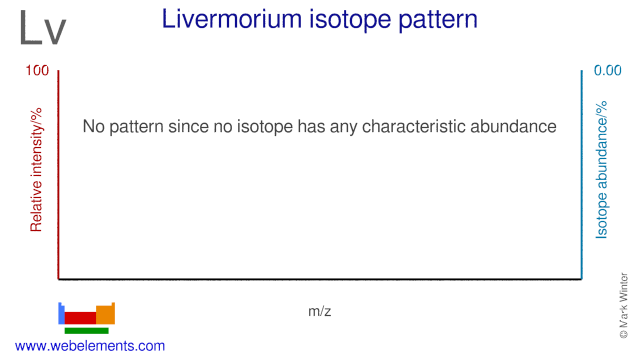Livermorium - 116Lv: the essentials
- Name: livermorium
- Symbol: Lv
- Atomic number: 116
- Relative atomic mass (Ar): [ 293.20 ] (longest lived isotope)
- Standard state: presumably a solid at 298 K
- Appearance: unknown, but probably metallic and silvery white or grey in appearance
- Classification: Metallic
- Group in periodic table: 16
- Group name: Chalcogen
- Period in periodic table: 7
- Block in periodic table: p
- Shell structure: 2.8.18.32.32.18.6
- CAS Registry: 54100-71-9
Livermorium atoms have 116 electrons and the shell structure is 2.8.18.32.32.18.6. The ground state electronic configuration of neutral livermorium is [Rn].5f14.6d10.7s2.7p4 (a guess based upon that of polonium) and the term symbol of livermorium is 3P2 (a guess based upon guessed electronic structure).
Livermorium: description
An isotope of livermorium, 292Lv, was identified in the reaction of 248Cm with 48Ca. It is very shortlived and decomposes to a known isotope of element 114, 288114Fl.
Livermorium: physical properties
Density of solid: 11200 (predicted) kg m-3
Molar volume: 26 (rough estimate based upon density estimate) cm3
Thermal conductivity: (no data) W m‑1 K‑1
Livermorium: heat properties
Melting point: (no data) K
Boiling point: (no data) K
Enthalpy of fusion: 20.5 kJ mol-1
Livermorium: atom sizes
Atomic radius (empirical): (no data) pm
Molecular single bond covalent radius: 175 (coordination number 2) ppm
van der Waals radius: (no data) ppm
Livermorium: electronegativities
Pauling electronegativity: (no data) (Pauling units)
Allred Rochow electronegativity: (no data) (Pauling units)
Mulliken-Jaffe electronegativity: (no data)
Livermorium: orbital properties
First ionisation energy: 724 kJ mol‑1
Second ionisation energy: (no data) kJ mol‑1
Third ionisation energy: (no data) kJ mol‑1
Livermorium: abundances
Universe: (no data) ppb by weight
Crustal rocks: (no data) ppb by weight
Human: (no data) ppb by weight
Livermorium: crystal structure

Livermorium: biological data
Human abundance by weight: (no data) ppb by weight
As only a very few atoms of livermorium have ever been made, it has no biological role.
Livermorium: uses
Livermorium: reactions
Reactions of livermorium as the element with air, water, halogens, acids, and bases where known.
Livermorium: binary compounds
Binary compounds with halogens (known as halides), oxygen (known as oxides), hydrogen (known as hydrides), and other compounds of livermorium where known.
Livermorium: compound properties
Bond strengths; lattice energies of livermorium halides, hydrides, oxides (where known); and reduction potentials where known.
Livermorium: history
Livermorium was discovered by Yu.Ts. Oganessian, V.K. Utyonkov, Yu.V. Lobanov, F.Sh. Abdullin, A.N. Polyakov, I.V. Shirokovsky, Yu.S. Tsyganov, G.G. Gulbekian, S.L. Bogomolov, B.N. Gikal, A.N. Mezentsev, S. Iliev, V.G. Subbotin, A.M. Sukhov, O.V. Ivanov, G.V. Buklanov, K.Subotic, M.G. Itkis, K.J. Moody, J.F. Wild, N.J. Stoyer, M.A. Stoyer, R.W. Lougheed, C.A. Laue, Ye.A. Karelin, and A.N. Tatarinov in 2000 at Dubna, Russia. Origin of name: lawrence Livermore National Laboratory (USA)..Livermorium: isotopes

Livermorium: isolation
Isolation: results published on the 6th December 2000 concerning recent experiments at Dubna in Russia (involving workers from The Joint Institute for Nuclear Research, Dubna, Russian Federation; The Lawrence Livermore National Laboratory, California, USA; The Research Institute of Atomic Reactors, Dimitrovgrad, Russian Federation; and The State Enterprise Electrohimpribor, Lesnoy, Russian Federation) describe the decay of the isotope 292Lv (produced in the reaction of 248Cm with 48Ca) to 292Fl.
24896Cm + 4820Ca → 292116Lv + 4 n
This decayed 47 milliseconds later as follows to a previously identified isotope of element 114, Fl.
292116Lv → 288114Fl + 42He
